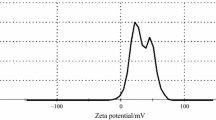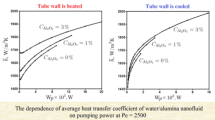Abstract
This work reports an experimental study of convective heat transfer of aqueous alumina nanofluids in a horizontal mini-channel under laminar flow condition 40 < Re < 1,000. The variation of local heat transfer coefficients, in both entrance and developed flow regimes, was obtained as a function of axial distance. The heat transfer coefficient of nanofluids was found to be dependent on not only nanoparticle concentration but also mass flow rate. Different to the behavior in conventional-sized channels, the major heat transfer coefficient enhancement is shown in the fully developed regime in the minichannel where up to 40% increase is observed. Discussions of the results suggest that apart from the need of a careful assessment of different thermo-physical properties of nanofluids, i.e., viscosity, specific heat and thermal conductivity, the heterogeneous nature of nanoparticle flow should be considered especially under high flow rate conditions.








Similar content being viewed by others
Abbreviations
- c :
-
Specific heat (J/kgK)
- D :
-
Diameter (m)
- h :
-
Heat transfer coefficient (W/m2K)
- k :
-
Thermal conductivity (W/mK)
- L :
-
Length (m)
- I :
-
Applied ampere (Amp)
- \( \dot{m} \) :
-
Mass flow rate (kg/s)
- P :
-
Pressure (Pa)
- Pr:
-
Prandtl number \( (Pr = \frac{c\mu }{k}) \)
- q ′′ :
-
Heat flux (W/m2)
- Q HL :
-
Heat loss power (W)
- Re :
-
Reynolds number \( (Re = \frac{\rho uD}{\mu }) \)
- T :
-
Temperature (K)
- V :
-
Applied voltage (Volt)
- u :
-
Velocity (m/s)
- ρ :
-
Density (kg/m3)
- μ :
-
Viscosity (Pa.s)
- ϕ :
-
Nanoparticle volume fraction
- ω :
-
Nanoparticle weight fraction
- f :
-
Fluid
- p :
-
Nanoparticle
References
Ahuja AS (1975) Augmentation of heat transport in laminar flow of polystyrene suspensions. I. Experiments and results. J Appl Phys 46:3408
Liu KV, Choi US, Kasza KE (1988) Measurement of pressure drop and heat transfer in turbulent pipe flows of particulate slurries. Argonne national laboratory report, ANL-88-15
Masuda H, Ebata A, Teramae K, Hishinuma N (1993) Alteration of thermal conductivity and viscosity of liquid by dispersing ultra-fine particles (dispersion of Al2O3, SiO2, and TiO2 ultra-fine particles). Netsu Bussei 4:227
Choi SUS (1995) Enhancing thermal conductivity of fluids with nanoparticles. In: Siginer DA, Wang HP (eds) Developments and applications of non-Newtonian flows. American Society of Mechanical Engineers, New York
Eastman J, Choi SUS, Li S, Yu W, Thompson LJ (2001) Anomalously increased effective thermal conductivities of ethylene-glycol-based nanofluids containing copper nanoparticles. Appl Phys Lett 78:718–720
Choi SUS, Zhang ZG, Yu W, Lockwood FE, Grulke EA (2001) Anomalous thermal conductivity enhancement in nanotube suspensions. Appl Phys Lett 79:2252–2254
Assael MJ, Chen CF, Metaxa I, Wakeham WA (2004) Thermal conductivity of suspensions of carbon nanotubes in water. Int J Thermophys 25:971–985
Venerus D, Buongiorno J, Christianson R et al (2000) Viscosity measurement of colloidal dispersion (nanofluids) for heat transfer applications. Appl Rheol 20:44582
Buongiorno J, Venerus D, Prabhat N et al (2009) A benchmark study on the thermal conductivity of nanofluids. J Appl Phys 106:94312–94314
Wen DS, Ding YL, Williams R (2006) Pool boiling heat transfer of aqueous based TiO2 nanofluids. J Enhanc Heat Transfer 13:231–244
Park KJ, Jung D (2007) Enhancement of nucleate boiling heat transfer using carbon nanotubes. Int J Heat Mass Transfer 50:4499–4502
Trisaksri V, Wongwises S (2009) Nucleate pool boiling heat transfer of TiO2-R141b nanofluids. Int J Heat Mass Transfer 52:1582–1588
Wen D, Lin G, Vafaei S, Zhang K (2009) Review of nanofluids for heat transfer applications. Particuology 7:141–150
Pak BC, Cho YI (1998) Hydrodynamic and heat transfer study of dispersed fluids with submicron metallic oxide particles. Exp Heat Transf 11:151–170
Yang Y, Zhang ZG, Grulke EA, Anderson WB, Wu G (2005) Heat transfer properties of nanoparticle-in-fluid dispersions (nanofluids) in laminar flow. Int J Heat Mass Transf 48:1107–1116
Jung JY, Oh HS, Kwak HY (2009) Forced convective heat transfer of nanofluids in microchannels. J Heat Mass Transf 52:466–472
Jung JY, Oh HS, Kwak HY (2008) Fluid flow and heat transfer in microchannels with rectangular cross section. Heat and Mass Transf 44:1041–1049
Xuan Y, Li Q (2003) Investigation on convective heat transfer and flow features of nanofluids. J Heat Transf 123:151–155
Chein R, Chuang J (2007) Experimental microchannel heat sink performance studies using nanofluids. Int J Therm Sci 46:57–66
Wen D, Ding Y (2004) Experimental investigation into convective heat transfer of nanofluids at the entrance region under laminar flow conditions. Int J Heat Mass Transf 47:5181–5188
Ding Y, Alias H, Wen D, Williams RA (2006) Heat transfer of aqueous suspensions of carbon nanotubes (CNT nanofluids). Int J Heat Mass Transf 49:240–250
Rea U, McKrell T, Hu LW, Buongiorno J (2009) Laminar convective heat transfer and viscous pressure loss of alumina-water and zirconia-water nanofluids. Int J Heat Mass Transf 52:2042–2048
Williams W, Buongiorno J, Hu LW (2008) Experimental investigation of turbulent convective heat transfer and pressure loss of alumina/water and zirconia/water nanoparticle colloids (nanofluids) in horizontal tubes. J Heat Transf 130:042412–042414
He Y, Jin Y, Chen H, Ding Y, Cang D, Lu H (2007) Heat transfer and flow behavior of aqueous suspensions of TiO2 nanoparticles (nanofluids) flowing upward through a vertical pipe. Int J Heat Mass Transf 50(11–12):2272–2281
Vafaei S, Wen D (2010) Critical heat flux (CHF) of subcooled flow boiling of alumina nanofluid in a horizontal microchannel. ASME J Heat Transf 132(10):102404
Lee J, Mudawar I (2007) Assessment of the effectiveness of nanofluids for single-phase and two-phase heat transfer in micro-channels. Int J Heat Mass Transf 50:452–463
Bergman TL (2009) Effect of reduced specific heats of nanofluids on single phase, laminar internal forced convection. Int J Heat Mass Transf 52:1240–1244
Wen D, Ding Y (2005) Effect of particle migration on heat transfer in suspensions of nanoparticles flowing through minichannels. Microfluid Nanofluidics 1:183–189
Wen D, Zhang L, He Y (2009) Flow and migration of nanoparticle in a single channel. Heat Mass Transf/Waerme- und Stoffuebertragung 45:1061–1067
Shah RK (1975) Thermal entry length solutions for the circular tube and parallel plates. In: Proceedings of 3rd national heat and mass transfer conference, vol 1, Indian Institute of Technology, Bombay, pp HMT-11-75
Lienhard JH IV, Lienhard JH V (2002) A heat transfer textbook, 2nd edn. Phlogiston press, Cambridge
Saidur R, Leong KY, Mohammad HA (2011) A review on applications and challenges of nanofluids. Renew Sustain Energy Rev 15:1646–1668
Acknowledgments
The authors would like to extend his thanks to EPSRC for financial support under Grant No. EP/E065449/1.
Author information
Authors and Affiliations
Corresponding author
Rights and permissions
About this article
Cite this article
Vafaei, S., Wen, D. Convective heat transfer of aqueous alumina nanosuspensions in a horizontal mini-channel. Heat Mass Transfer 48, 349–357 (2012). https://doi.org/10.1007/s00231-011-0887-4
Received:
Accepted:
Published:
Issue Date:
DOI: https://doi.org/10.1007/s00231-011-0887-4




